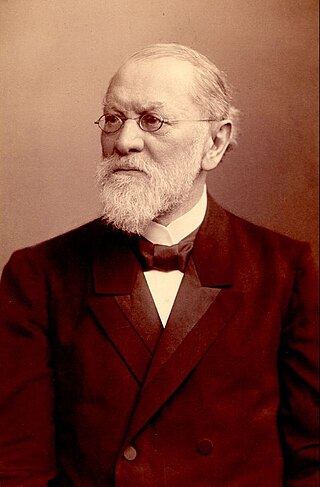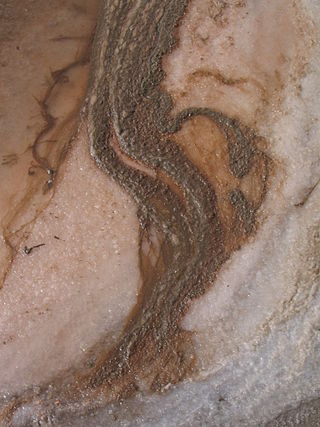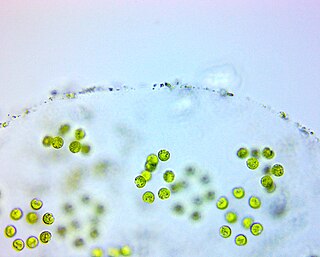
Chlamydomonadales, also known as Volvocales, are an order of flagellated or pseudociliated green algae, specifically of the Chlorophyceae. Chlamydomonadales can form planar or spherical colonies. These vary from Gonium up to Volvox. Each cell has two flagella, and is similar in appearance to Chlamydomonas, with the flagella throughout the colony moving in coordination.
Cryptomonas is the name-giving genus of the Cryptomonads established by German biologist Christian Gottfried Ehrenberg in 1831. The algae are common in freshwater habitats and brackish water worldwide and often form blooms in greater depths of lakes. The cells are usually brownish or greenish in color and are characteristic of having a slit-like furrow at the anterior. They are not known to produce any toxins. They are used to feed small zooplankton, which is the food source for small fish in fish farms. Many species of Cryptomonas can only be identified by DNA sequencing. Cryptomonas can be found in several marine ecosystems in Australia and South Korea.
Chromulinales is an order of Chrysophyceae, golden-brown algae or golden algae. It was first identified and defined by Adolf Pascher (1881–1945) in 1910.

Nathanael Pringsheim was a German botanist.
Thorea is a genus of freshwater algae in the Phylum Rhodophyta. Thorea is a small alga with filaments up to 200 cm long, dark green in colour and not red as are marine Rhodophyta. The filaments have only as few secondary branches.

Chlamydomonadaceae is a family of algae within the order Chlamydomonadales.

Dunaliellaceae is a family of algae in the order Chlamydomonadales.

The Tetrasporaceae are a family of green algae, specifically of the Chlamydomonadales.
Apjohnia is a genus of green algae in the family Siphonocladaceae.

Bornetella is a genus of green algae in the family Dasycladaceae.

Paulschulzia is a genus of green algae, specifically of the family Tetrasporaceae.
Pseudoscourfieldia is a genus of green algae in the family Pycnococcaceae.
Rosenvingiella is a genus of green algae in the family Prasiolaceae.

Schroederiella is a genus of green algae in the family Scenedesmaceae.

Scourfieldia is a genus of green algae in the family Scourfieldiaceae. Cardiomona Korshikov is an invalid synonym.
Treubaria is a genus of green algae, the sole genus in the family Treubariaceae.

Achlya is a genus of oomycete, in the family Saprolegniaceae. The genus includes several plant pathogens including Achlya conspicua and Achlya klebsiana. Unlike many other microorganisms, cell expansion is governed by changes in cell wall strength rather than changes in osmotic pressure. The genome of Achlya hypogyna has been sequenced and can be accessed on public online databases, for example on the NCBI website.
Sirodotia Kylin (1912) is a genus of freshwater red alga which was described by Kylin in 1912, and placed in the Batrachospermaceae family.

Chrysococcus is a genus of golden algae in the family Dinobryaceae.

Ochromonas is a genus of algae belonging to the family Chromulinaceae.












